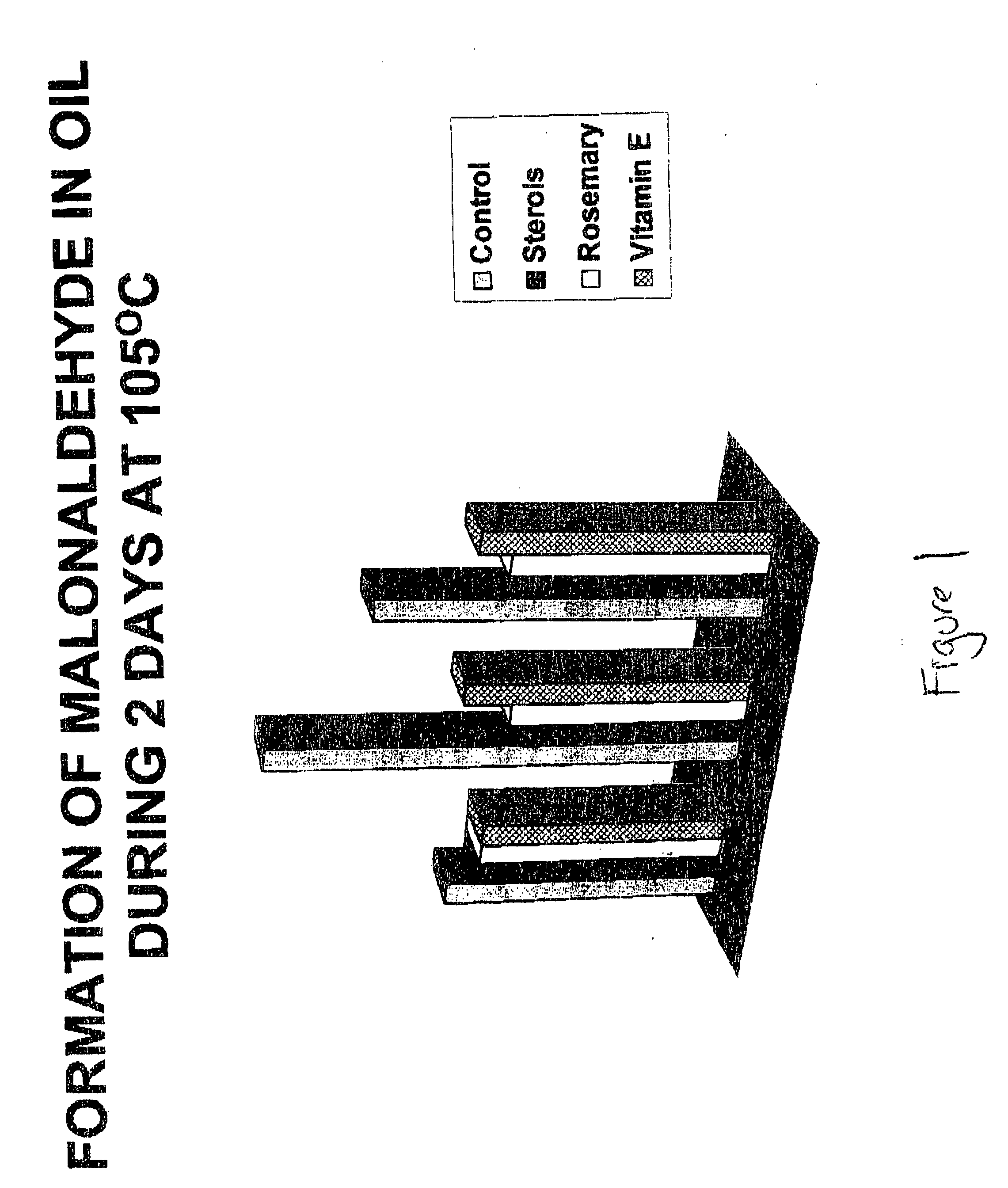Method of preservation of a food prodcut and composition comprising one or more phytosterols and/or phytostanols useful for this purpose
a technology of phytosterols and/or phytostanols, applied in the field of food preservation, can solve the problems of food products not always being stored in the most ideal conditions, food contamination, deterioration or spoilage, etc., and achieve the effects of reducing fat and oil oxidation, flexible molecule, and reducing the risk of oxidative rancidity
- Summary
- Abstract
- Description
- Claims
- Application Information
AI Technical Summary
Benefits of technology
Problems solved by technology
Method used
Image
Examples
example 1
Preparation of Yoghurt Comprising Microparticulates of Phytosterols and / or Phytostanols
[0133] A composition of plant sterols / stanols having campesterol (14.5%), campestanol (2.4%), beta-sitosterol (50.9%) and sitostanol (18.9%) (hereinafter referred to as “Reducol™”) was mixed with non-fat milk powder in the ratio of 1:7 to 1:8. About 6 L of milk mix was prepared from whole milk, skimmed milk and the Reducol containing milk powder. Milk was standarized to 0.76-1% fat, 12-13% solids and 0.5-1% Reducol using the Pearson's Square method (Hyde, K A and Rothwell, J. 1973, in Ice Cream, Churchill Livingstone Ltd., London U.K.). The milk mix was permitted to remain at room temperature for 30 minutes to re-hydrate the milk powder and then it was homogenized using a high-speed microfluidizer commercially available from Microfluidics Corporation, Newton, Mass. (USA). Next, milk was then pasteurized at 69° C. (156° F.) for 30 minutes (batch / vat), cooled to 44° C. and held at this temperature ...
example 2
Preparation of a Vegetable Spread / Emulsion Comprising Microparticulates of Phytosterols and / or Phytostanols
[0135] A mixture of soybean oil and palm oil with Reducol in the concentration range of 50-80% can be used to develop an emulsion. A small portion of hydrogenated vegetable oil (2-5%) can be added in order to obtain the desired texture. Two types of emulsions are possible: oil-in-water, which is preferable for the development of the low-fat spread and water-in-oil, which is preferable for some other applications. Appropriate emulsifiers or stabilizing agents such as lecithin, polysorbates and lactylates are used to stabilize the emulsion. Thickening agents such as gums (xanthan gum, locust bean gum, guar gum etc.), gelatin, pectins, and agar may also be added. To colour the spread, beta-carotene, caramel colour and FD&C yellow dye may be used. Furthermore, enriching the oil phase with vitamins A and D as well as with essential polyunsaturated fatty acids is possible.
[0136] A ...
example 3
Preparation of a Cereal Bar Comprising Microparticulates of Phytosterols and / or Phytostanols
[0138] It has been found by the applicants herein that Reducol can be dispersed in fat up to 27% (and possibly more). For this reason, cereal bars having fat-based binders have been investigated. In this example, Reducol is dispersed in fat to form a continuous emulsion. This fat component is then combined with carbohydrates and optionally with other ingredients to form a binder suitable to maintain the strength and elastic properties of the cereal bar.
a) Binder
[0139] Generally, the fat-binder composition in cereal bars ranges from about 20-85% fat, and 20-60% carbohydrates by weight. The strength of the cereal bar is improved with the addition of up to 1% monoglycerides and diglycerides, however, since they have relatively high melting points compared to triglycerides, they should be used only in small proportions. Optionally, various emulsifiers, film formers (e.g. sodium caseinate or a...
PUM
 Login to View More
Login to View More Abstract
Description
Claims
Application Information
 Login to View More
Login to View More - R&D
- Intellectual Property
- Life Sciences
- Materials
- Tech Scout
- Unparalleled Data Quality
- Higher Quality Content
- 60% Fewer Hallucinations
Browse by: Latest US Patents, China's latest patents, Technical Efficacy Thesaurus, Application Domain, Technology Topic, Popular Technical Reports.
© 2025 PatSnap. All rights reserved.Legal|Privacy policy|Modern Slavery Act Transparency Statement|Sitemap|About US| Contact US: help@patsnap.com



